|
|
| RESEARCH ACTIVITIES |
 |
| Bismuth-doped Near Infrared Luminescent Materials |
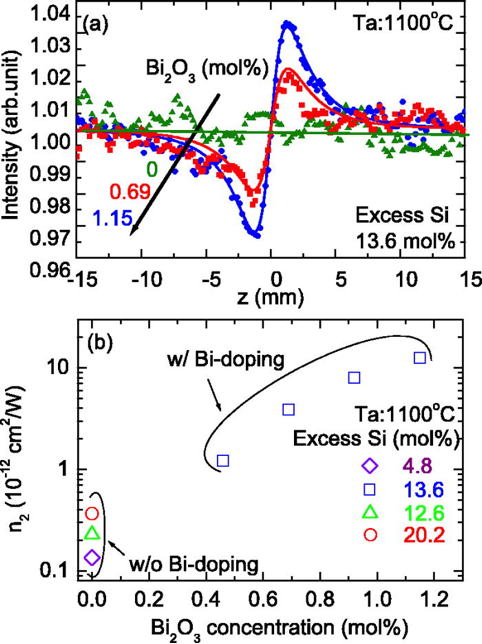 |
170. Kenji Imakita, Yuya Tsuchihashi, Ryo Naruiwa, Minoru Fujii, Hong-Tao Sun, Jianrong Qiu, and Shinji Hayashi,
Ultrafast nonlinear optical responses of bismuth doped silicon-rich silica films
Applied Physics Letters, Volume 101,Issue 19, 191106, pp. 1-4 (2012).
|
| Nonlinear optical responses of bismuth (Bi) doped silicon-rich silicon
dioxide (Si-rich SiO2) films were studied by a z-scan and an optical Kerr
gate method under femtosecond excitation around 800 nm. It was found that
the Bi-doping enhances the nonlinear optical response of Si-rich SiO2 films
by several orders of magnitudes. The nonlinear refractive index was of
the order of 10−11 cm2/W and the response time was shorter than our time
resolution of 100 fs. The nonlinear refractive index was independent of
the wavelength in the range from 750 to 835 nm, suggesting that virtual
transitions are involved in the nonlinear optical processes. |
|
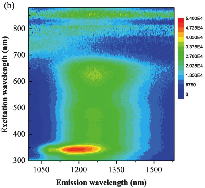 |
169. Hong-Tao Sun, Yoshio Sakka, Naoto Shirahata, Minoru Fujii, and Tetsu Yonezawa,
Near-infrared photoluminescence from molecular crystals containing tellurium
Journal of Materials Chemistry, Vol. 22, pp. 24792–24797 (2012). |
| We report the observation of near-infrared photoluminescence from
Te4(Ga2Cl7)2 and Te4(Al2Cl7)2 molecular crystals containing Te42+ polycations.
The experimental and theoretical results clearly revealed that the Te42+
polycation is a smart near-infrared emitter with characteristic emission
peaks at 1252 and 1258 nm for Te4(Ga2Cl7)2 and Te4(Al2Cl7)2 crystals, respectively,
resulting from the intrinsic electronic transitions of Te42+. Furthermore,
it was also found that the emissions strongly depend on the excitation
wavelengths for both Te4(Ga2Cl7)2 and Te4(Al2Cl7)2 samples, most possibly
due to the co-existence of other Te-related optically active centers. This
research not only enriches the species of luminescent charged p-block element
polyhedra and deepens the understanding of Te-related photophysical behaviors,
but also may stimulate efforts for designing novel material systems using
such active centers. It is also greatly expected that these sub-nanometer
optically active species could exist in other systems such as glasses,
polymers, and bulk optical crystals, and the stabilization of these centers
in widely used hosts will pave the way for their practical applications. |
|
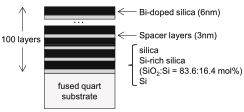 |
167. Satoshi Morimoto, Minoru Fujii, Hong-Tao Sun, Yuji Miwa, Kenji Imakita, Jianrong Qiu, and Shinji Hayashi,
Broadband near-infrared emission from bismuth-doped multilayer films
Journal of Applied Physics, Vol. 112, 073511, pp. 1-4 (2012). |
![[ABSTRACT]](logo312.gif) Multilayer structures consisting of bismuth (Bi)-doped silica thin films
and different kinds of spacer, i.e., Si, silica, Si-rich silica, layers
are grown and the luminescence properties are studied. When samples were
annealed at a low temperature, Bi-related near infrared active centers
(BRACs) were formed at interfaces between Bi-doped silica and Si-rich silica
(or silicon) due to the reduction of Bi3þ to BRACs by silicon. On the other
hand, films annealed at a high temperature showed similar emission behaviors
to bulk glasses. The results demonstrated here establish a new strategy
for the control of BRACs and building peculiar Bi activated film structures. Multilayer structures consisting of bismuth (Bi)-doped silica thin films
and different kinds of spacer, i.e., Si, silica, Si-rich silica, layers
are grown and the luminescence properties are studied. When samples were
annealed at a low temperature, Bi-related near infrared active centers
(BRACs) were formed at interfaces between Bi-doped silica and Si-rich silica
(or silicon) due to the reduction of Bi3þ to BRACs by silicon. On the other
hand, films annealed at a high temperature showed similar emission behaviors
to bulk glasses. The results demonstrated here establish a new strategy
for the control of BRACs and building peculiar Bi activated film structures. |
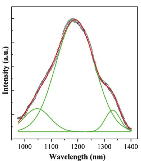 |
166. Hong-Tao Sun, Tetsu Yonezawa, Miriam M. Gillett-Kunnath, Yoshio Sakka, Naoto Shirahata, Sa Chu Rong Gui, Minoru Fujii and Slavi C. Sevov,
Ultra-broad near-infrared photoluminescence from crystalline (K-crypt)2Bi2 containing [Bi2]2- dimers
Journal of Materials Chemistry, Vol.22, Issue 38, pp. 20175-20178 (2012). |
| For the first time, we report that a single crystal of (K-crypt)2Bi2 containing
[Bi2]2− displays ultra-broad near-infrared photoluminescence (PL) peaking
at around 1190 nm and having a full width at the half maximum of 212 nm,
stemming from the inherent electronic transitions of [Bi2]2−. The results
not only add to the number of charged Bi species with luminescence, but
also deepen the understanding of Bi-related near-infrared emission behavior
and lead to the reconsideration of the fundamentally important issue of
Bi-related PL mechanisms in some material systems such as bulk glasses,
fibers, and conventional optical crystals. |
|
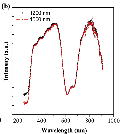 |
165. Hong-Tao Sun, Beibei Xu, Tetsu Yonezawa, Yoshio Sakka, Naoto Shirahata, Minoru Fujii,Jianrong Qiu and Hong Gao,
Photoluminescence from Bi5(GaCl4)3 molecular crystal
Dalton Transactions, Vol. 41, pp.11055–11061 (2012). |
| Bi5(GaCl4)3 sample has been synthesized through the oxidation of Bi metal
by gallium chloride (GaCl3) salt. Powder X-ray diffraction as well as micro-Raman
scattering results revealed that, in addition to crystalline Bi5(GaCl4)3
in the product, an amorphous phase containing [GaCl4]− and [Ga2Cl7]− units
also exists. The thorough comparison of steady-state and time-resolved
photoluminescent behaviors between the Bi5(GaCl4)3 product and Bi5(AlCl4)3
crystal leads us to conclude that Bi53+ is the dominant emitter in the
product, which gives rise to the ultrabroad emission ranging from 1 to
2.7 μm. Detailed quantum chemistry calculation helps us assign the observed
excitations to some electronic transitions of the Bi53+ polycation, especially
at shorter wavelengths. It is believed that our work shown here is not
only helpful to solve the confusions on the luminescent origin of bismuth
in other material systems, but also serves to develop novel broadband tunable
laser materials. |
|
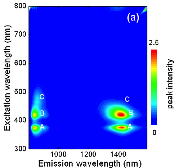 |
159. Sa chu rong gui, Kenji Imakita, Minoru Fujii, Zhenhua Bai, Shinji Hayashi,
Luminescence properties of Bi-doped oxidized porous silicon thin films
Optical Materials, Vol. 34, pp. 1161-1164 (2012). |
| Luminescence properties of Bi-doped oxidized porous silicon (OPS)
thin films were studied. It was found that this material shows two broad
luminescence bands centered at 845 nm with the FWHM of 120 nm and at 1410
nm with that of 220 nm under 488 nm excitation. A detailed analysis of
the 3D plot of PL intensities versus excitation and emission wavelengths
revealed that these luminescence bands arise from at least two different
kinds of Bi luminescence centers. The broad luminescence covering the whole
telecommunication window (1.2–1.6 μm) suggests that Bi-doped OPS thin films
can be a candidate material for a broadband waveguide-type optical amplifier
at optical telecommunication wavelengths. |
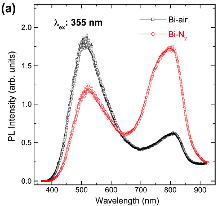 |
156. Zhenhua Bai, Minoru Fujii, Takashi Hasegawa, Shohei Kitanoa, Kenji Imakita, Minoru Mizuhatab, and Shinji Hayashi,
Co-existence of Bi with multiple valence states in zeolites-controlling the optical properties by annealing atmosphere
Optical Materials, Vol. 34 , pp. 821-825 (2011).
|
| We investigate the effect of annealing atmosphere on the optical properties
of Bi doped zeolites by diffuse reflectance, steady state and time-resolved
photoluminescence (PL), and PL excitation measurements. The results reveal
that zeolites can be used as an excellent host material to stabilize multiple
Bi centers (Bi3+, Bi2+, and Bi-related near-infrared (NIR) active centers)
in the framework, which shows ultra-broadband emission from visible to
NIR range. Annealing in N2 leads to the partial conversion of Bi3+ ions
into Bi2+ and Bi-related NIR active centers. Our results demonstrate that
the broadband NIR emission may be attributed to the electronic transition
of Bi low valence state, rather than a higher valence state. |
|
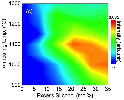 |
154. Yuji Miwa, Hong-Tao Sun, Kenji Imakita, Minoru Fujii, Yu Teng, Jianrong Qiu, Yoshio Sakka, and Shinji Hayashi,
Sensitized broadband near-infrared luminescence from bismuth-doped silicon-rich silica films
Optics Letters, Vol. 36, No. 21, pp. 4221-4223, November 1 (2011). |
| Developing Si compatible optical sources has attracted a great deal
of attention owing to the potential for forming inexpensive, monolithic
Si-based integrated devices. In this Letter, we show that ultra broadband
near-IR (NIR) luminescence in the optical telecommunication window of silica
optical fibers was obtained for Bi-doped silicon-rich silica films prepared
by a co-sputtering method. Without excess Si, i.e., Bi-doped pure silica
films, no luminescence was observed in the NIR range. A broad Bi-related
NIR photoluminescence appears when excess Si was doped in the Bi-doped
silica. The luminescence properties depended strongly on the amount of
excess Si and the annealing temperature. Photoluminescence results suggest
that excess Si acts as an agent to activate Bi NIR luminescence centers
and also as an energy donor to transfer excitation energy to the centers.
It is believed that this peculiar structure might find some important applications
in Si photonics. |
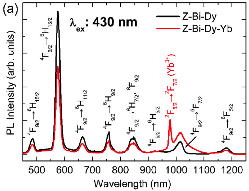 |
153. Zhenhua Bai, Minoru Fujii, Takashi Hasegawa, Kenji Imakita,Minoru Mizuhata and Shinji Hayashi,
Efficient ultraviolet-blue to near-infrared downconversion in Bi-Dy-Yb doped zeolites
Journal of Physics D: Applied Physics, Vol. 44, pp. 455301 1-5 (2011). |
| Ultraviolet-blue to near-infrared (NIR) downconversion is investigated
for the Dy3+–Yb3+ couple in zeolites by steady-state and time-resolved
photoluminescence (PL) spectra, and PL excitation spectra. Upon excitation
of the 4F9/2 level of Dy3+, NIR quantum cutting could occur through a two-step
energy transfer from one Dy3+ ion to two neighbouring Yb3+ ions via an
intermediate level. The energy transfer efficiency from the 4F9/2 level
is estimated to be 42%, and the intrinsic PL quantum efficiency of Yb3+
emission reaches 54%. The findings may have potential application in enhancing
the energy efficiency of silicon-based solar cells. |
|
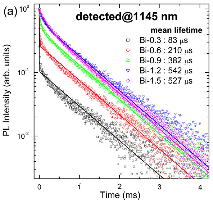 |
147. Zhenhua Bai, Minoru Fujii, Takashi Hasegawa, Kenji Imakita, Yuji Miwa,
Minoru Mizuhata, and Shinji Hayashi
Effect of doping concentration on broadband
near-infrared emission of Bi doped zeolites
Microporous and
Mesoporous Materials, Vol. 145, pp. 21-25 (2011). |
| A series of Bi doped zeolites are prepared by an ion-exchange process by
changing doping concentration in a wide range, and the optical properties
are investigated. The near-infrared photoluminescence (PL) intensity, full
width at half maximum and decay time depend strongly on Bi doping concentration.
The PL intensity increases 178 times when the concentration is changed
from 0.3 to 1.5 at. %. At the same time, the lifetime increases from 83
to 527 μs. The results prove the model that doped Bi acts not only as optically
active centers, but also as pore-sealing substances to isolate the centers.
The comparison of PL and Raman data suggests that in addition to previously
proposed Bi2O3, other Bi-related materials, probably Bi metal, play an important role to isolate the active centers. |
 |
146. Hong-Tao Sun, Yoshio Sakka, Hong Gao, Yuji Miwa, Minoru Fujii, Naoto
Shirahata, Zhenhua Bai and Ji-Guang Li,
Ultrabroad near-infrared photoluminescence
from Bi5(AlCl4)3 crystal
Journal of Materials Chemistry, Vol.
21, pp. 4060-4063 (2011). |
| The Bi5(AlCl4)3
crystal, synthesized by a environmentally friendly room-temperature method using
ionic liquids as reaction solvents, exhibits extremely broad near-infrared
photoluminescence (PL) with a full width at the half maximum (FWHM) of >510
nm and an effective PL lifetime of 4.1 µs at 1160 nm. We envision that this
study not only extends the understanding of photophysical properties of
materials containing subvalent bismuth, but also may have promise for the design
of novel photonic materials containing a wide array of p-block elements. |
|
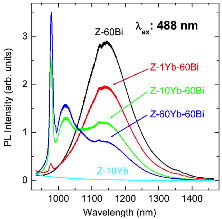 |
145. Zhenhua Bai, Hong-Tao Sun, Minoru Fujii, Yuji Miwa,Takashi Hasegawa, Minoru
Mizuhata and Shinji Hayashi,
Bismuth-sensitized Efficient Near-infrared
Luminescence from Ytterbium in Zeolites
Journal of Physics D:
Applied Physics, Vol. 44, 155101, pp. 1-5 (2011). |
| Yb–Bi co-doped zeolites are prepared by a method consisting of a simple
ion-exchange process and subsequent high-temperature annealing. We observe
two strong near-infrared (NIR) emission bands overlapping in the range
930–1480 nm, corresponding to the electronic transitions of bismuth-related
active centres (BiRAC) and Yb3+ ions, respectively. In the obtained products,
the excitation wavelength of Yb3+ is extended to the range 420–850 nm,
and the lifetime reaches 665 µs. In the zeolite matrix, Bi ions exist as
BiRAC and Bi compound agglomerates. The former act as a sensitizer of Yb3+
ions, and the latter act as a blockage to seal the pores of zeolites, which
enables Yb3+ ions to show efficient NIR emission even if the zeolites contain
a large amount of coordinated water. The excellent optical and structural
properties make these NIR-emitting nanoparticles promising in applications
as biological probes. |
|
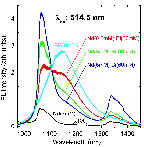 |
144. Zhenhua Bai, Minoru Fujii, Yuki Mori, Yuji Miwa, Minoru Mizuhata, Hong-Tao
Sun, and Shinji Hayashi,
Efficient Near-infrared Emission from
Neodymium by Broadband Sensitization of Bismuth in Zeolites
Optics Letters, Vol. 36, No. 6,
pp. 1017-1019 (2011) . |
| Nd-Bi codoped zeolites were prepared by an ion-exchange process, and the
optical properties were investigated by photoluminescence (PL) and PL excitation
spectra, and decay time measurements. The results show that the NIR emission
of Nd3+ ions is significantly enhanced by the introduction of bismuth in
codoped samples, and the lifetime reaches 246 μs. It is also observed that
NIR-active Bi acts as a sensitizer of Nd3+ ions. The energy transfer efficiency
is also estimated. The peculiar optical properties make Nd-Bi codoped zeolites
promising for potential application in biological probes. |
|
| |
141. Hong-Tao Sun, Junjie Yang, Minoru Fujii, Yoshio Sakka, Yufang Zhu,
Takayuki Asahara, Naoto Shirahata, Masaaki Ii, Zhenhua Bai, Ji-Guang Li,
and Hong Gao,
Highly Fluorescent Silica-Coated Bismuth-Doped Aluminosilicate Nanoparticles for Near-Infrared Bioimaging
Small, Vol. 7, No. 2, pp. 199-203 (2011) . |
| The combined advantages of bismuth and aluminosilicates lead to a new type
of nanosized biolabel. The near-infrared (NIR)-emitting silica-coated bismuth-doped
aluminosilicate nanoparticles are simple to prepare and exhibit a broad
excitation band in the first biological window, efficient long-lived photoluminescence
(PL) covering the second window, high photostability, low cytotoxicity,
and easy penetration into living tissues. In vivo PL bioimaging and decay
are tested in living mice. |
|
| |
140. Hong-Tao Sun, Yoshio Sakka, Minoru Fujii, Naoto Shirahata, and Hong Gao,
Ultrabroad Near-infrared Photoluminescence from Ionic Liquids Containing Subvalent Bismuth
Optics Letters, Vol. 36, No. 2, pp. 100-102 (2011) .
|
| We have shown that Lewis-acidic halogenoaluminate ionic liquid (IL) containing
subvalent bismuth can be used as a near-IR (NIR) luminescent material.
Raman and absorption spectra evidence the coexistence of Bi3+5 and Bi+
in the liquid. The Bi3+5 and Bi+ emitters, stabilized by this Lewis-acidic
liquid, demonstrate ultrabroad NIR photoluminescence with a lifetime of
around 1μs. We envisage that the bismuth activated ILs would not only enrich
the well-established spectrum of soft luminescent materials but also might
promote the design of novel photonic materials activated by other p-block
elements. |
|
| |
137. Hong-Tao Sun, Yoshio Sakka, Yuji Miwa, Naoto Shirahata, Minoru Fujii, and Hong Gao
Spectroscopic Characterization of Bismuth Embedded Y Zeolites
Applied Physics Letters, Vol. 97, 131908 pp. 1-3 (2010). |
| Bismuth embedded Y zeolites were studied by using UV-vis- near infrared
(NIR) diffuse reflectance, Raman, and steady-state NIR photoluminescence
spectroscopy. The results suggest that Bi53+ and Bi+ active centers coexist
in the dehydrated and hydrated zeolite framework, both of which contribute
to NIR emission. Furthermore, it was revealed that the high-temperature
annealing leads to the formation of Bi2O3 clusters, which act as blocks
for selectively closing down the “in-out windows” of H2O and O2 molecules
in the zeolites. It is believed that these materials can find a wide array
of applications as active media of broadly tunable micro or nano-optical
sources. |
|
| |
132. Hong-Tao Sun, Fumiaki Shimaoka, Yuji Miwa, Jian Ruan, Minoru Fujii, Jianrong Qiu, and Shinji Hayashi,
Sensitized superbroadband near-IR emission in bismuth glass/Si nanocrystal superlattices
Optics Letters, Vol. 35, Issue 13, pp. 2215-2217 (2010) . |
| We show that sensitized superbroadband near-IR (NIR) emission in bismuth glass/Si nanocrystal superlattices can be realized. Photoluminescence is enhanced by 1 order of magnitude in this structure. We observed that the excitation wavelength dependence of the NIR emission does not show any distinct structure corresponding to the direct transition of bismuth IR-active centers. Our results suggest that the enhanced emission might result from the energy transfer from Si nanocrystals to IR-active bismuth. This structure may find broad applications for broadband amplifiers and broadly tunable laser sources. |
|
| |
131. Zhenhua Bai, Hong-Tao Sun, Takashi Hasegawa, Minoru Fujii, Fumiaki Shimaoka,
Yuji Miwa, Minoru Mizuhata, and Shinji Hayashi,
Efficient near infrared luminescence and energy transfer in erbium/bismuth co-doped zeolites
Optics Letters, Vol. 35, Issue 11, pp. 1926 - 1928 (2010) . |
| We have shown that tunable and highly efficient broadband near-IR (NIR)
luminescence can be realized in erbium/bismuth codoped zeolites. The emission
covers the ranges of 930–1450nm and 1450–1630nm. The intensity ratio of
the two bands can be tuned by adjusting the concentration of erbium and
the excitation wavelength. Steady-state and time-resolved photoluminescence
(PL), and PL excitation measurements indicate that two kinds of emitters
coexist in the pores of zeolites, and that NIR active bismuth simultaneously
acts as a sensitizer of erbium. The present results demonstrate an important
rational strategy for the design of a tunable NIR-emitting zeolite-based
nanosystem. |
|
| |
129. Hong-Tao Sun, Minoru Fujii, Yoshio Sakka, Zhenhua Bai, Naoto Shirahata, Liyan Zhang, Yuji Miwa, and Hong Gao
Near-infrared photoluminescence and Raman characterization of bismuth-embedded sodalite nanocrystals
Optics Letters, Vol. 35, Issue 11, pp. 1743-1745 (2010) . |
| Ultrabroadband near-IR (NIR) emission has been realized in bismuth-embedded
sodalite nanocrystals. Steady-state and time-resolved photoluminescence
and Raman results suggest that Bi+ active centers contribute to the NIR
emission. This study demonstrates that sodalite nanocrystals can serve
as excellent hosts for bismuth NIR active centers, thus paving the way
for their wide applications in nanophotonics. |
|
|
125. Hong-Tao Sun, Akinobu Hosokawa, Yuji Miwa, Fumiaki Shimaoka,Minoru Fujii, Minoru Mizuhata, Shinji Hayashi, and Shigehito Deki
“Strong Ultrabroadband Near-Infrared Photoluminescence from Bismuth Embedded Nanocrystalline Zeolites and Their Derivatives,”
Advanced Materials, Vol. 21, pp. 3694–3698 (2009). |
| Zeolites with embedded bismuth compounds display strong, air-stable, long-lived, ultrabroadband, and tunable near-infrared photoluminescence (see picture). Bismuth ions not only act as luminescence-active centers, but also as blocks for selectively closing the “in–out windows” of water molecules. Bismuth active centers can be sealed in a low-vibrational environment by bismuth agglomerates even when the sample still contains a large amount of water. |
|
|
117. Hong-Tao Sun, Takashi Hasegawa, Minoru Fujii, Fumiaki Shimaoka,
Zhenhua Bai, Minoru Mizuhata, Shinji Hayashi, and Shigehiko Deki,
"Highly-Efficient and Air-stable Near Infrared Emission in Erbium/Bismuth Codoped Zeorites,”
Applied Physics Letters, Vol. 94, 141106, pp. 1-3 (2009). |
| We have shown that highly efficient and air-stable 1531 nm emission can
be realized in erbium/bismuth codoped zeolites. The luminescence lifetime
of Er3+ at 1531 nm can reach up to 4.2 ms. Bismuth compounds formed by
high temperature annealing can act as blockages of selectively closing
down the “in-out windows” of water molecules, i.e., Er3+ ions are sealed
in a low-vibrational environment by bismuth agglomerates even when the
samples contain a large amount of water. This finding may pave the way
for the applications of active ions doped porous materials in infrared
photonics. |
|
|
116. Hong-Tao Sun, Y. Miwa, Fumiaki Shimaoka, Minoru Fujii, A. Hosokawa, Minoru Mizuhata, Shinji Hayashi, and Shigehito Deki,
"Superbroadband Near Infrared Nano Optical Source Based on Bismuth Doped High-silica Nanocrystalline,”
Optics Letters, Vol. 34, Issue 8, pp. 1219-1221 (2009).
|
| We have shown that efficient superbroadband near-IR luminescence can be
realized in bismuth-doped high-silica nanocrystalline zeolites. The emission
band covered the range of 930-1620 nm, with a maximum peak at 1146.3 nm,
an FWHM of 152 nm, and a lifetime of over 300 μs under the excitation of
a 488 nm laser line. The observed luminescence was attributed to subvalent
Bi (Bi+) ions formed in the annealed zeolites. These Bi-doped nanozeolites
may find applications as superbroadband near-IR nano-optical sources. |
|
|
115. Hong-Tao Sun, Takashi Hasegawa, Minoru Fujii, Fumiaki Shimaoka, Zhenhua Bai, Minoru Mizuhata, Shinji Hayashi, and Shigehito Deki,
"Significantly Enhanced Superbroadband Near Infrared Emission in Bismuth/Aluminum Doped High-Silica Zeolite Derived Nanoparticles,”
Optics Express, Vol. 17, No. 8, pp. 6239-6244 (2009). |
| Significantly enhanced superbroadband near infrared emission has been realized in bismuth/aluminum doped high-silica zeolite derived nanoparticles. The emission intensity can be easily tailored by the introduction of aluminum. The luminescence lifetime can reach up to 695 μs. The results reveal that the existence of charge imbalance environment caused by [AlOV4/2]- units in host materials is requisite to the formation of infrared-active Bi+. The finding presents a feasible route to design highefficient bismuth activated infrared luminescent nanoparticles. These bismuth doped nanoparticles may find applications as superbroadband near infrared nano optical sources. |
|
| |
| |
| |
| |
|
|
|
|
|
|

|
|
|

